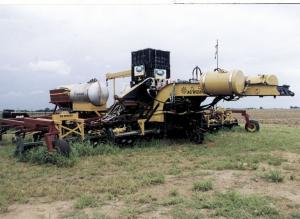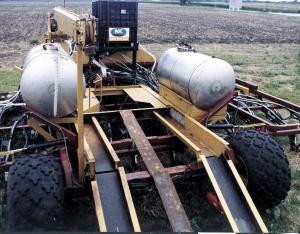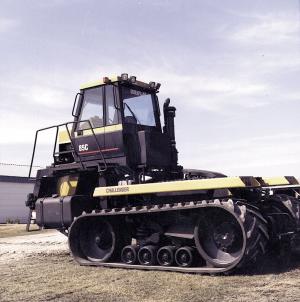1999 - Volume #23, Issue #5, Page #19
[ Sample Stories From This Issue | List of All Stories In This Issue | Print this story
| Read this issue]
Giant New Planter: The Rest Of The Story
 |
 |
 |
We recently stopped by his farm to see how the planter turned out and discovered that the giant 40-ft. planter has features on it you won't find anywhere else. He calls it the "Ag Wizard cargo cart".
Scheetz chose the Canadian-built Seed Hawk as the basis for his planter because he felt it could plant no-till corn, beans and wheat with more efficiency than any planter he'd ever seen in the Midwest. "It's a high-capacity, one-pass rig that lets me plant all my crops in narrow rows," says Scheetz. "The great thing about the design of the Seed Hawk is that it gives you narrow rows under true no-till conditions without plugging up. I used it last fall to plant 300 acres of wheat in 12-in. rows."
The air seeder is equipped with three gangs of widely-spaced, hydraulic-operated row units that simply clamp onto the frame. Each row unit mounts on a 7-ft. arm fitted with a hydraulic cylinder. The cylinder applies downpressure to a pair of 1/2-in. wide "fracturing knives" that place seed and fertilizer in the ground with minimal sidewall compaction.
Seed gravity flows down to Valmar seed meters mounted on front of the rig's frame and is then blown back to the knives. Hydraulic-driven roto-tillers mount ahead of the planter units. A ground-driven wheel in front puts the seed and fertilizer meters into gear.
Scheetz welded a semi trailer detachable fifth wheel hitch and platform onto the air seeder's frame. The fifth wheel hitch carries all the weight of the planter. Two 125-gal. hydraulic oil reservoirs mount on the hitch to supply oil to operate the tillers, and two 500-gal. water tanks mount on back of the platform. A hydraulic-powered winch pulls a 1,500-gal. anhydrous wagon right up onto the planter. A hydraulic-powered boom lifts a bulk seed container up onto the planter, too.
Scheetz has set a goal of raising 300 bu. per acre corn next year, which requires a lot of nitrogen fertilizer. To accomplish this he's equipped the planter to convert anhydrous ammonia into liquid fertilizer right in the field. A heat exchanger injects anhydrous ammonia into a reactor, along with a water pump which injects water into the reactor. This mixture is then converted into a liquid nitrogen form. The liquid nitrogen is delivered through hoses and injected into the ground 1 1/2 in. off to the side and 3 in. below the seed openers. Redball monitors let him keep an eye on the amount of fertilizer going to each row.
"As far as I know converting anhydrous to liquid nitrogen in the field is the only way to apply huge amounts of nitrogen without it being in an anhydrous form," says Scheetz. "I borrowed the idea from sugar cane growers in Louisiana. My goal is to apply 285 units of nitrogen per acre. If that nitrogen was all applied as anhydrous ammonia I'd have to apply 325 lbs. of anhydrous per acre, which would harm both the soil and the seed. Also, much of it would escape from the ground. The advantage of liquid nitrogen is that it doesn't produce vapors like anhydrous so it can be placed closer to the seed without burning it. My conversion process converts the anhydrous to 62 percent liquid nitrogen which, unlike 32 percent liquid fertilizer, can't be stored in an open container so I have to make it in the field. Another advantage of this conversion process is that I have to take only half as much water to the field as I would with 32 percent liquid nitrogen."
Scheetz adds that by next spring he plans to replace the rubber wheels on back of the planter with tracks for better flotation in soft ground.
Contact: FARM SHOW Followup, Tim Scheetz, 2141 N. Co. Rd. 900 E., Nauvoo, Ill. 62354 (ph 217 453-2599).

Click here to download page story appeared in.

Click here to read entire issue
To read the rest of this story, download this issue below or click here to register with your account number.




